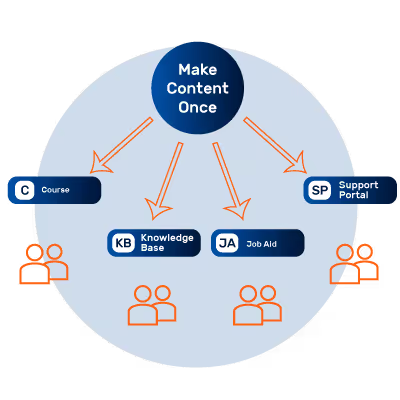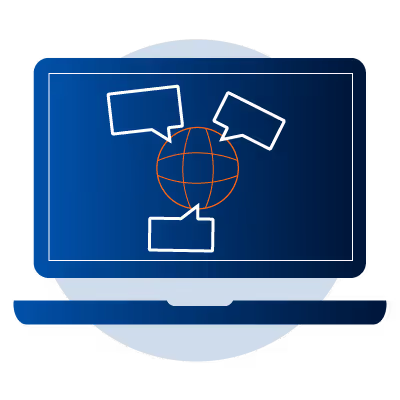Unlocking Efficiency with Single-Sourced Learning Content



In the rapidly evolving field of eLearning, the ability to innovate and streamline content creation and distribution is crucial. Modern tools and strategies are transforming how learning content is created, managed, and delivered, enabling organizations to achieve greater efficiency and effectiveness.
One of the most transformative approaches in eLearning is single sourcing.
The Concept of Single Sourcing

Single sourcing allows content creators to develop a piece of content once and use it across multiple formats and platforms. The advantage of single sourcing lies in its efficiency—rather than recreating the wheel with every new requirement, teams can adapt a single source of content for various uses, saving time and reducing errors.
Single sourcing not only facilitates the management of content updates—ensuring consistency and accuracy across all platforms—but also adapts to different learning environments. Whether it’s a live training session, an eLearning module, or an on-demand knowledge base, single sourcing ensures that learners receive the same core information, presented in a way that suits the context of their learning experience.
For instance; a company needs to train employees on a new software tool. With single sourcing, the initial training content can be used in a live webinar, repurposed for a self-paced online course, and made available as a reference in a searchable knowledge base. This approach ensures that all learners have access to consistent information, regardless of how they choose to engage with the material.
Benefits of Single Sourcing
To summarize, many benefits accrue to those who use this strategy for developing content.
- Consistency and Accuracy: Single sourcing ensures that all learners receive the same core information, regardless of the format or platform. This consistency is crucial in maintaining the integrity and reliability of the training content. When updates are made to the source content, these changes are automatically reflected across all formats, reducing the risk of inconsistencies and errors.
- Efficiency and Time Savings: By creating content once and reusing it across multiple platforms, organizations can save significant time and resources. This efficiency allows content creators to focus on enhancing and expanding the content rather than duplicating efforts for different formats. For example, a single source document can be adapted for an instructor-led training session, an eLearning module, and a printable guide, all from the same original content.
- Flexibility and Adaptability: Single sourcing allows for easy customization of content for different audiences and learning environments. Content can be tailored to specific roles, experience levels, or learning contexts without the need for multiple versions. For instance, training content for customer service representatives can be adapted for beginners and advanced users by simply adjusting the visibility of certain sections or adding role-specific information.
- Reduced Maintenance: Maintaining multiple versions of the same content can be a logistical nightmare, especially when updates are needed. Single sourcing simplifies this process by ensuring that all updates are made in one place and automatically propagated across all formats. This reduces the maintenance burden and ensures that all learners have access to the most current information.
Practical Examples of Single Sourcing
- Corporate Training Programs: A multinational corporation needs to provide compliance training to employees in different regions. By using single sourcing, the company can create one comprehensive training module and translate it into multiple languages. Updates to regulations can be made to the single source document and instantly reflected in all language versions, ensuring compliance across the board in one fell swoop.
- Educational Institutions: Universities and colleges can use single sourcing to develop course materials that are used in both in-person and online classes. Professors can create lecture notes, slides, and study guides from a single source, ensuring that all students, regardless of their mode of learning, receive the same information.
- Healthcare Training: A healthcare provider needs to train staff on new medical procedures. Single sourcing allows the creation of training content that can be used in live workshops, online training modules, and as part of a searchable knowledge base for on-demand reference. This ensures that all staff members have access to the same high-quality training materials.
Enhancing Learner and Creator Experience
For content creators, the appeal of single sourcing is in its capacity to tailor content without the need to duplicate efforts. Tools that support component-based design, like modern design platforms, allow creators to adjust elements such as layouts, fonts, and the visibility of content components based on the audience and delivery mode. This not only makes the content more relevant and engaging for learners but also significantly cuts down on the workload for developers.
From learners, single sourcing means that content can be personalized to fit their needs without compromising the quality or integrity of the information provided. For instance, customer service representatives can receive training that is specific to the particular products they support, with content automatically adjusted for beginner or advanced levels, ensuring that all learners have access to the information that is most relevant to their roles.
Additionally, this approach supports continuous improvement. As feedback is gathered from various training sessions, updates can be made to the single source content, instantly improving the learning experience across all platforms. This iterative process not only enhances the quality of training but also keeps it aligned with the evolving needs of the learners.
Streamlining Distribution with Modern Tools
The distribution of eLearning content is another area where innovations in technology can lead to significant improvements. Traditional methods, which often involve multiple steps to publish and distribute content, are being replaced by more integrated and automated systems. These new tools allow for real-time updates across all platforms, eliminating the need for manual re-uploads and ensuring that learners always have access to the latest information.
Moreover, these advanced systems support responsive design, meaning that eLearning content is accessible and optimized for any device, enhancing the learning experience regardless of how or where the learner accesses the material. Whether accessing training on a desktop at work or on a smartphone during a commute, learners can enjoy a seamless experience.
For example, an organization might create a training module that is initially designed for desktop viewing. With responsive design, the same module can be accessed on a tablet or smartphone without sacrificing usability or readability. This flexibility is particularly valuable in today’s mobile-centric world, where learners expect to be able to access information on the go.
The Global Scale: Multi-Language Support

In a globalized business environment, the ability to provide training in multiple languages is essential. Single sourcing extends into multi-language support by maintaining a single content source that can be dynamically translated and adapted for various linguistic needs. This approach not only simplifies the creation and maintenance of multi-language training materials but also ensures that updates are universally applied, reducing the risk of inconsistencies.
As mentioned earlier, a multinational company might need to provide compliance training to employees in several countries. With single sourcing, the core training content can be developed once and then translated into multiple languages. Any updates to the content are automatically reflected across all language versions, ensuring that all employees receive the most current information.
This approach also supports cultural customization, allowing organizations to adapt content to better fit the cultural context of different regions. By doing so, training becomes more relevant and engaging for international learners, enhancing their overall learning experience.
Conclusion
The future of eLearning lies in leveraging technologies that simplify content creation and distribution while enhancing the learning experience. Single sourcing, supported by modern tools and collaborative platforms, represents a significant step forward in achieving these goals. As organizations continue to innovate in their learning strategies, the focus will remain on delivering personalized, responsive, and efficient training solutions that meet the diverse needs of their global workforce.
By embracing these innovations, organizations can not only improve the efficiency of their training programs but also create a more engaging and effective learning environment for their employees. This holistic approach to eLearning ensures that all learners have access to high-quality, relevant training that supports their professional growth and the organization’s success.
Related Resources
.avif)
New to IDIODC?
Instructional Designers in Offices Drinking Coffee (#IDIODC) is a free weekly eLearning video cast and podcast that is Sponsored by dominknow.
Join us live – or later in your favourite app!
Try the most dynamic course authoring LCMS for free
dominKnow | ONE has all the tools your team needs to create and distribute training content across your ecosystem.



.svg)






